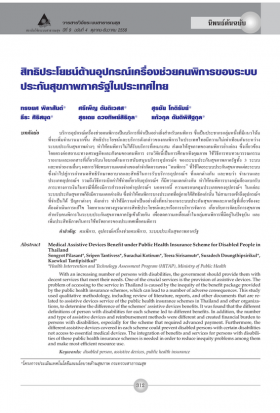This website uses cookies so that we can provide you with the best user experience possible. Cookie information is stored in your browser and performs functions such as recognising you when you return to our website and helping our team to understand which sections of the website you find most interesting and useful.
สิทธิประโยชน์ด้านอุปกรณ์เครื่องช่วยคนพิการของระบบประกันสุขภาพภาครัฐในประเทศไทย

รายละเอียดเพิ่มเติม
ทรงยศ พิลาสันต์
ศรีเพ็ญ ตันติเวสส
สุรชัย โกติรัมย์
ธีระ ศิริสมุด
สุรเดช ดวงทิพย์สิริกุล
แก้วกุล ตันติพิสิฐกุล
Abstract:
บริการอุปกรณ์เครื่องช่วยคนพิการเป็นบริการที่จำเป็นอย่างยิ่งสำหรับคนพิการ ซึ่งเป็นประชากรกลุ่มหนึ่งที่มีแนวโน้มที่จะเพิ่มจำนวนมากขึ้น สิทธิประโยชน์และบริการดังกล่าวของคนพิการในประเทศไทยมีความไม่เท่าเทียมกันระหว่างระบบประกันสุขภาพต่างๆ ทำให้คนพิการไม่ได้รับบริการที่เหมาะสม ส่งผลให้สุขภาพของคนพิการย่ำแย่ลง ซึ่งเกี่ยวข้องโดยตรงต่อสถานะทางเศรษฐกิจและสังคมของคนพิการ งานวิจัยนี้เป็นการศึกษาเชิงคุณภาพ ใช้วิธีการทบทวนวรรณกรรม รายงานและเอกสารที่เกี่ยวกับนโยบายด้านการสนับสนุนบริการอุปกรณ์ฯ ของระบบประกันสุขภาพภาครัฐทั้ง 3 ระบบและหน่วยงานอื่นๆ ผลการวิจัยพบความแตกต่างของคำจำกัดความของ “คนพิการ” ที่ใช้โดยระบบประกันสุขภาพแต่ละระบบ ซึ่งนำไปสู่การกำหนดสิทธิรักษาพยาบาลและสิทธิในการรับบริการอุปกรณ์ฯ ที่แตกต่างกัน และพบว่า จำนวนและประเภทอุปกรณ์ฯ รวมถึงวิธีการเบิกค่าใช้จ่ายเกี่ยวกับอุปกรณ์ฯ ก็มีความแตกต่างกัน ทำให้คนพิการบางกลุ่มต้องแบกรับภาระทางการเงินในกรณีที่ต้องมีการสำรองจ่ายค่าอุปกรณ์ฯ นอกจากนี้ ความครอบคลุมประเภทของอุปกรณ์ฯ ในแต่ละระบบประกันสุขภาพก็ยังมีความแตกต่างกัน ซึ่งทำให้คนพิการบางประเภทที่อยู่ภายใต้สิทธิเหล่านั้น ไม่สามารถเข้าถึงอุปกรณ์ฯ ที่จำเป็นได้ ปัญหาต่างๆ ดังกล่าว ทำให้มีความจำเป็นอย่างยิ่งที่หน่วยงานระบบประกันสุขภาพและภาครัฐที่เกี่ยวข้องจะต้องดำเนินการแก้ไข โดยหาแนวทางบูรณาการสิทธิประโยชน์และ/หรือการบริหารจัดการ เกี่ยวกับการจัดบริการสุขภาพสำหรับคนพิการในระบบประกันสุขภาพภาครัฐเข้าด้วยกัน เพื่อลดความเหลื่อมล้ำในกลุ่มคนพิการที่มีอยู่ในปัจจุบัน และเพิ่มประสิทธิภาพในการใช้ทรัพยากรของประเทศเพื่อคนพิการ
Abstract:
With an increasing number of persons with disabilities, the government should provide them with decent services that meet their needs. One of the crucial services is the provision of assistive devices. The problem of accessing to the service in Thailand is caused by the inequity of the benefit package provided by the public health insurance schemes, which can lead to a number of adverse consequences. This study used qualitative methodology, including review of literature, reports, and other documents that are related to assistive devices service of the public health insurance schemes in Thailand and other organizations, to determine the difference of the schemes’ assistive devices benefits. It was found that the different definitions of person with disabilities for each scheme led to different benefits. In addition, the number and type of assistive devices and reimbursement methods were different and created financial burden to persons with disabilities, especially for the scheme that required advanced payment. Furthermore, the different assistive devices covered in each scheme could prevent disabled persons with certain disabilities not access to essential medical devices. The integration of benefits and services for persons with disabilities of these public health insurance schemes is needed in order to reduce inequity problems among them and make most efficient resource use.




